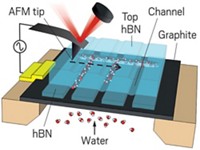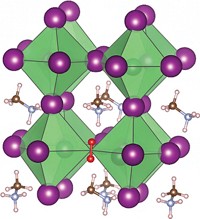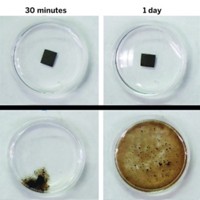Advertisement
Grab your lab coat. Let's get started
Welcome!
Welcome!
Create an account below to get 6 C&EN articles per month, receive newsletters and more - all free.
It seems this is your first time logging in online. Please enter the following information to continue.
As an ACS member you automatically get access to this site. All we need is few more details to create your reading experience.
Not you? Sign in with a different account.
Not you? Sign in with a different account.
ERROR 1
ERROR 1
ERROR 2
ERROR 2
ERROR 2
ERROR 2
ERROR 2
Password and Confirm password must match.
If you have an ACS member number, please enter it here so we can link this account to your membership. (optional)
ERROR 2
ACS values your privacy. By submitting your information, you are gaining access to C&EN and subscribing to our weekly newsletter. We use the information you provide to make your reading experience better, and we will never sell your data to third party members.
Materials
Diamond's Surface Conductivity
Charge transfer to aqueous redox couple may explain unusual surface properties
by Jyllian Kemsley
December 3, 2007
| A version of this story appeared in
Volume 85, Issue 49

Diamonds are more than a girl's best friend. Pure diamond is insulating, but it can be made conductive by doping or exposure to air. Its conductive properties are of interest for a range of electronic and biological applications.
How undoped diamond develops surface conductivity in air had been unknown, but a team of researchers led by John C. Angus, a professor of chemical engineering at Case Western Reserve University, has now solved the mystery. The group has demonstrated that in humid air, a thin film of water on undoped diamond allows transfer of electrons from the diamond surface to an aqueous redox couple involving O2. The finding, reported in Science (2007, 318, 1424), may provide insight into surface properties of other materials.
Previously, a group led by Lothar Ley, a professor of physics at Friedrich Alexander University of Erlangen-Nuremberg, in Germany, had proposed that an aqueous redox mechanism might be the source of diamond's surface conductivity (Phys. Rev. Lett. 2000, 85, 3472). Until now, however, researchers had investigated the electrical characteristics of diamond in different environments rather than studying them with electrochemistry experiments. "What is great about the Science paper is that it approaches the problem of transfer doping and surface conductivity from the chemistry point of view," Ley says.
The finding comes from several experiments. In one, Case Western Reserve graduate student Vidhya Chakrapani added diamond powder to aqueous solutions of different pH. The large surface area of the powder generated enough electron transfer to produce measurable changes in pH and oxygen concentration. Control experiments using anaerobic solutions demonstrated the need for oxygen.
Another set of experiments involved dipping a twinned single crystal of diamond into water and measuring the force on the crystal due to wetting. The researchers then used the measured force to calculate a contact angle (a property of liquid-solid interactions). By analyzing contact angles, they were able to explain why hydrophobic diamond would attract a layer of water: As more electrons transfer from diamond to water, an electrostatic attraction develops between the positively charged diamond surface and the compensating anions in the aqueous phase; greater attraction is manifested in a shallower contact angle.
Angus also notes that "there are water films on everything" and suggests that charge transfer between a surface and an aqueous redox couple may be a more general phenomenon that has gone unrecognized until now. Angus and colleagues have observed that charge transfer affects luminescence of gallium nitride, and they speculate that it might explain humidity-dependent characteristics of mechanical friction and why charge carriers in vacuum-annealed, single-walled carbon nanotubes change from electrons to positively charged holes when the tubes are exposed to air.





Join the conversation
Contact the reporter
Submit a Letter to the Editor for publication
Engage with us on Twitter